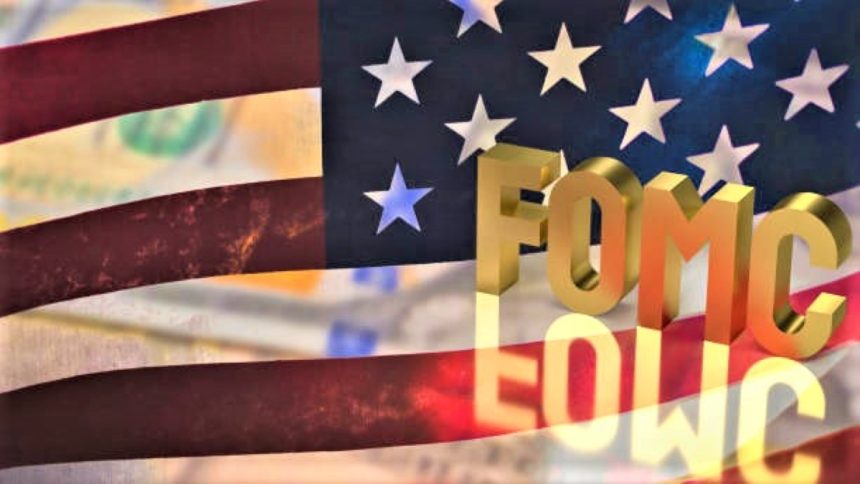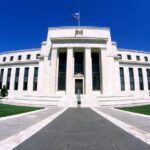The financial world awaits the U.S. Federal Reserve interest rate announcement. In today’s FOMC decision, we expect the Fed to hold interest rates steady in its monetary policy announcement for the fourth consecutive meeting. Recent market consensus, as indicated by tools like CME Group’s FedWatch, strongly supports the decision. This cautious approach reflects the Fed’s desire for greater clarity on the economic ripple effects of a wide array of government policy changes.
Let’s dive into what the move means, why it matters, and how it fits into the broader economic landscape, including its implications for commodities like gold.
Federal Reserve’s Interest Rates, Policy Shifts, and Economic Uncertainty
A Wait-and-See Strategy
The Fed’s decision to maintain the status quo stems from uncertainty surrounding recent U.S. government initiatives. This includes the massive $2 trillion bipartisan infrastructure bill that was passed in 2021. As a 2023 study by the National Bureau of Economic Research (NBER) plausibly highlighted, such large-scale investments coupled with ongoing debates over tax reforms indeed create complex and unpredictable impacts on inflation and employment. As the economy continues to navigate these challenges, Fed officials are adopting a data-driven strategy, delaying any adjustments to borrowing costs until they have a clearer understanding of the situation.
This hesitancy marks a shift from historical patterns. During the 2008 financial crisis, for instance, the Fed famously slashed rates by 5% in a matter of months to stimulate a faltering economy. Today’s measured stance suggests a new era of caution, influenced by global economic volatility. Most notably, there is a significant 20% surge in oil prices, which adds another layer of complexity to the Federal Reserve decision on interest rates. In May, the inflation rate slightly increased to 2.4% from 2.3% in April, adding to the complexity and challenging the Fed’s delicate balance.
The Dovish Dilemma
Market expectations largely lean toward a “dovish” monetary policy meeting, where officials might signal a willingness to lower rates to spur growth. This optimism, however, is at odds with rising oil prices, which are unequivocally stoking inflationary pressures. Bloomberg’s data consistently shows significant fluctuations in the dollar’s value, reflecting a constant struggle between these opposing forces. This tension underscores the Fed’s dual mandate: maintaining price stability while maximizing employment. This balancing act is becoming increasingly challenging in today’s environment.
The interplay between a potentially dovish stance and rising oil costs is leading dollar traders in divergent directions. This volatility underscores the delicate balance the Fed is maintaining, carefully calibrating each step to prevent the economy from entering a recession or overheating. The FOMC’s “dot plot,” a key indicator of future interest rate expectations, is pivotal today. However, a 2025 study from the Journal of Monetary Economics suggests that median dot projections often underestimate market volatility by 15-20% due to diverse policymaker views, a crucial consideration for market participants.
What’s Next for the Economy?
The Fed’s reluctance to act swiftly reflects a broader recognition that government policy changes, ranging from infrastructure spending to trade tariffs, carry long-term consequences that are difficult to predict in real-time. For instance, the infrastructure bill’s projected boost to GDP (2.9% in 2023 and 2.4% in 2024, as widely reported by analysts like Moody’s Analytics) could fuel growth. However, this growth also risks increasing the national debt to 124% of GDP by 2034 if not offset by credible funding, as consistently warned by organizations like the Peter G. Peterson Foundation based on CBO projections.
For businesses and consumers, this uncertainty means borrowing costs are likely to remain stable in the near term, offering a reprieve but also limiting the immediate stimulus that lower rates might provide. Meanwhile, the surge in global oil prices could erode purchasing power, increasing household pressure and prompting the Fed to closely monitor inflation data in the upcoming months.
FOMC Influence on Gold Price Forecast
The FOMC’s stance on interest rates is a critical driver for gold, a non-yielding asset that typically moves inversely to real interest rates. A hawkish outcome, signaling higher rates, could strengthen the U.S. dollar and pressure gold prices downward, as investors seek yield-bearing alternatives. Conversely, a dovish surprise (lower rates or a pause) often boosts gold, with historical data from Federal Reserve studies consistently indicating an average 10% price increase following dovish FOMC announcements. With today’s decision looming, traders are positioning for a potential breakout, influenced by both macroeconomic cues and chart patterns.
Gold (XAU/USD) is currently trading below $3,400, reflecting trader caution before the Federal Reserve interest rate meeting. Analysts from reputable firms widely expect the current interest rate to hold, influencing gold’s safe-haven status. Furthermore, escalating geopolitical tensions, like the anticipated U.S. involvement in the Iran-Israel conflict, could significantly boost gold demand as a safe haven, potentially countering any bearish pressure from a more hawkish Fed stance.
XAUUSD Trading Strategy Amid Federal Reserve interest rate Decision
As the financial markets prepare for the Federal Reserve interest rate (FOMC) decision today, traders are focusing on the gold price forecast and its potential response to this crucial US monetary policy event to create an actionable XAUUSD trading strategy. Based on the technical analysis and supported by market insights, let’s dive into a detailed technical analysis and XAUUSD trading strategy.
Technical Setup: Falling Channel and OBV Confirmation
Before the FOMC decision, XAUUSD is currently trading within a falling channel, a classic bearish pattern characterized by lower highs and lower lows. This setup suggests a consolidation phase, with the price awaiting a catalyst, likely the FOMC outcome on US monetary policy, to trigger a decisive breakout. The key level to watch is $3355; if XAUUSD remains above $3355 with On-Balance Volume (OBV) confirmation, the next move targets will be $3450-$3500.
To refine this strategy, we reference the daily On-Balance Volume (OBV), a cumulative indicator that tracks volume flow to confirm price trends. OBV rises with strong buying pressure (volume on up days outpacing down days) and falls with selling pressure, offering a glimpse into underlying market sentiment. If the price reaches $3355, near the daily OBV support, we could see the market targeting a range of $3450-$3500. This aligns with recent Citi Research projections, which have indeed raised their 3-month gold price target to $3,500, citing robust Chinese demand and safe-haven flows amid tariff risks and market uncertainty. Similarly, Goldman Sachs consistently reiterates a bullish call, forecasting gold to reach $3,700 by the end of 2025 and $4,000 by mid-2026, while J.P. Morgan‘s 2025-2026 outlook also suggests new gold price highs driven by USD diversification trends.
Risk Management
Because there might be big price changes after the FOMC decision meeting, it’s important to keep your investment size to 1-2% of your total account and watch for sudden increases in trading volume, since the On-Balance Volume (OBV) can be affected by large trades from big investors.
Key Considerations
The Federal Reserve interest rate decision’s impact hinges on the Fed’s tone and accompanying economic projections. A dovish pivot could catalyze the anticipated rally, supported by the broader bullish sentiment and USD diversification trends. However, a hawkish stance might invalidate this setup, pushing gold toward support levels near $3250. Traders should also watch for divergences between price and OBV, which could foreshadow a reversal if selling pressure resurfaces.
A Final Thought from Our Desk
Today’s FOMC decision on US monetary policy is a microcosm of the larger challenges facing central banks globally: navigating complex economic forces while geopolitical currents churn. For traders, the uncertainty means that understanding the macro picture, from fiscal policy to oil prices, is just as crucial as mastering the technicals of a specific asset like gold. The Fed’s deliberate caution signals a recognition that the old playbooks might not apply neatly to new complexities. This interconnectedness is both a challenge and an opportunity; it demands a holistic view, where every economic data point and geopolitical headline can influence your next trade. As we move forward, adaptability and informed decision-making will be your greatest assets.









